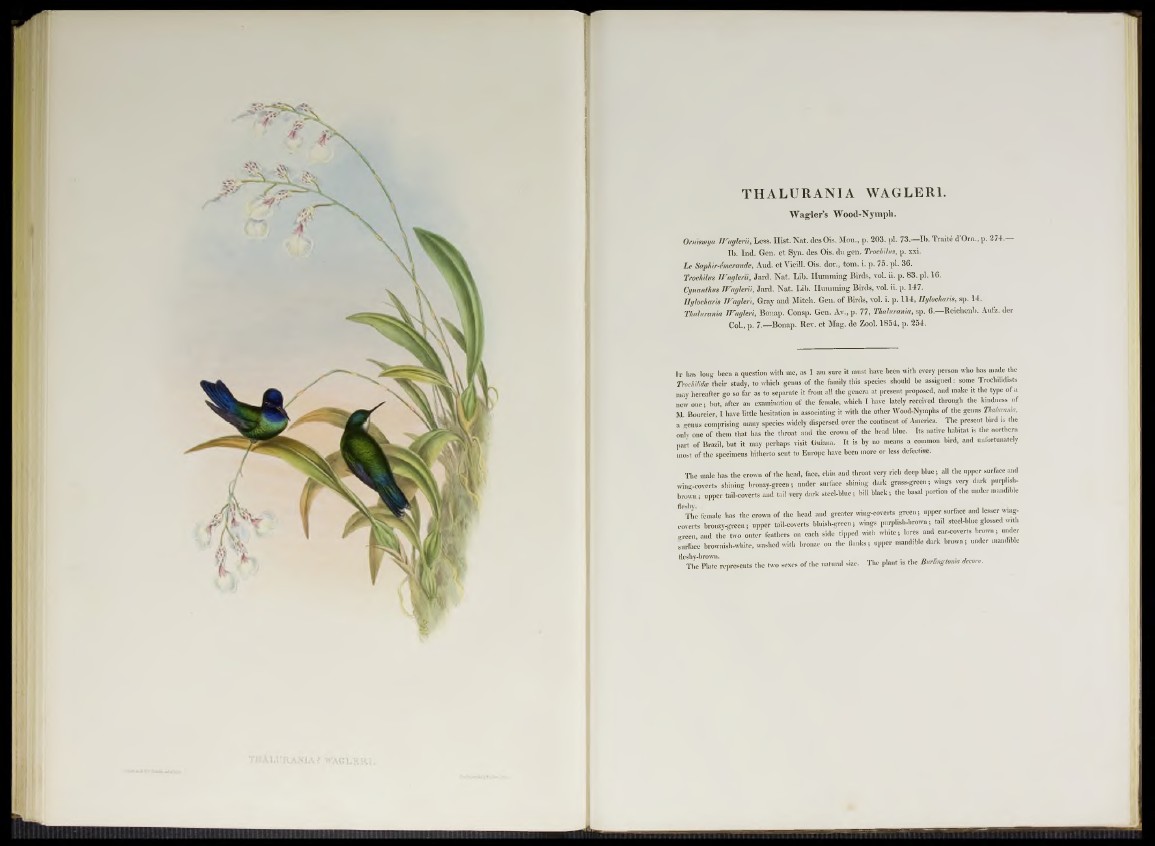
THALURANIA WAGLERI.
Wag'ler’s Wood-Nymph.
Ornumya Warjlerii, Less. H ist. Nat. des Ois. Mou., p. 203. pl. 73.—Ib. Traité d’Orn., p. 274.—
Ib. Ind. Gen. et Syn. des Ois. du gen. Trochilus, p. xxi.
Le Saphir-émeraude, Aud. etVieill. Ois. dor., tom. i. p. 75. pl. 36.
Troe/iilia Waglmi, Jard. Nat. Lib. Humming Birds, vol. ii. p. 83. pl. 16.
Cynanthus Waglerü, Jard. Nat. Lib. Humming Birds, vol. ii. p. 147.
Eyloehark Waglrn, Gray and Mitch. Gen. of Birds, vol. i. p. 114, Eylocharis, sp. 14.
Thalurania Wagleri, Bonap. Consp. Gen. Av., p. 77, Thalurania, sp. 6.—Reichenb. Aufz. der
Col., p. 7.— Bonap. Rev. et Mag. de Zool. 1854, p. 254.
It has long been a qnestion with me, as I am snre it must have been with every person who has made the
Trochilida their sludy, to which genus of the family this species should be assigued: some Trochilidists
inay hereafter go so far as to separate it from all the genera at present proposed, and make it the type of a
new one; but, after an examination of the female, which I have lately received through the kindness of
M Bourcier, I have little hesitation in associating it with the other Wood-Nymphs of the genus Thahrama,
a genus comprising many species widely dispersed over the continent of America. The present bird is the
only one of them that has the throat and the erown of the head blue. Its native habitat is the northern
part of Brazil, but it may perhaps visit Guiana. It is by no means a common bird, and unfortunately
most of the specimens hitherto sent to Europe have been more or less defective.
The male has the crowu of the head, fece, chin and throat very rich deep blue; all the upper surface and
wing-coverts shining bronzy-green; under surface shining dark grass-green; wings very dark purphsh-
brown ; upper tail-coverts and tail very dark steel-blue; bill black; the basal portion of the under mandible
fl<The female has the crown of the head and greater wing-coverts green; upper surface and lesser wing-
coverts bronzy-green; upper tail-coverts bluish-green; wings purplish-brown; tail steel-blue glossed with
green, and the two outer feathers on each side tipped with white; lores aud ear-eoverts brown; under
surface brownish-white, washed with bronze on the flanks; upper mandible dark brown; under mandible
ileshy-brown. . I „ ,
The Plate represents the two sexes of the natural size. The plant is the Burlmgtoma decora.